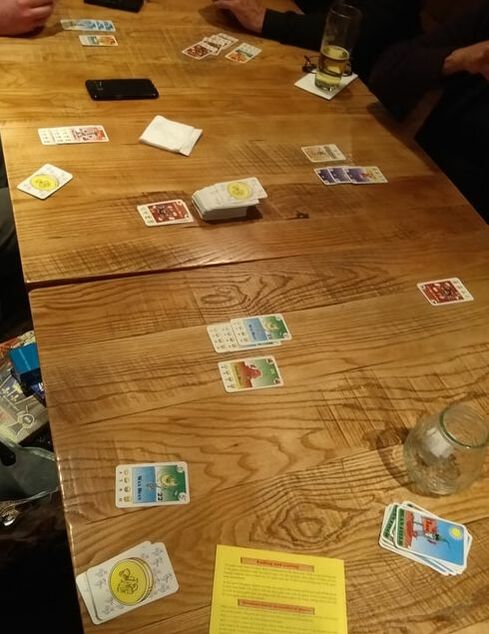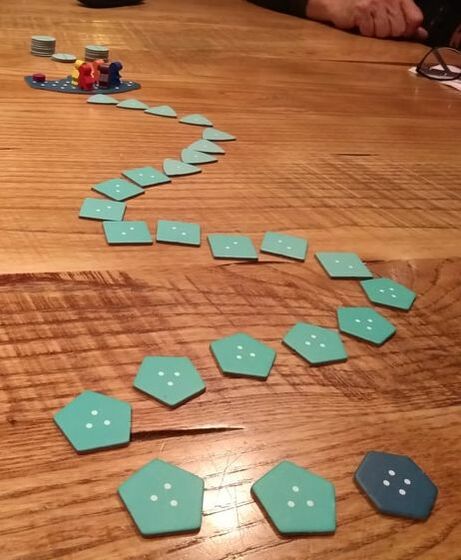|
12th February Gaming night at The Sovereigns in Woking Bohanza is a card game about growing beans and trading beans. Mostly it's about trading beans. Bohanza is a 'set-collecting' game with a great little wrinkle. Unusually, it supports up to 7 players and on this occasion we got up to 7! I've never played it with that many people - excellent! Gameplay is reasonably simple. First, there is one important rule everyone must remember. At the start of the game, each player is dealt a hand of cards.
This rule is the crux of the game, it's what drives the entire game. Here's why.
So you need to get rid of the wrong cards in your card before you have to play them. How do you do that? You trade them away of course. Once the active player has played their mandatory card, they can choose to play another card from their hand. After this, they draw 2 cards from the deck and places in them in front them in the play area. Now trading begins. At this point, the active player can trade any card from their hand, or any of the 2 face up cards with any other player. The active player can also 'donate' cards to other players (although the other player can reject the offer). Curiously other players can try to donate card to the active player. Trades can only occur with the active player. Once trading has concluded, all traded cards must be immediately planted. If the active player still as any of the 2 face up cards they just drew. And that's how trading is done. The only other thing to explain is selling crops. Players can sell a crop at pretty much any time. This will earn them up to 4 gold, depending on how many cards they have collected for that set. Different beans require different amounts of cards to earn gold. The player then keeps a number of cards from the set as their gold. The remaining cards are placed into the discard pile. This is worthy of noting, because not all the cards from a set is put back into the set. When the draw deck is depleted, the discard pile is shuffled and becomes the draw deck. This is done twice (thus the deck played through a total of 3 times). Once the deck is depleted a 3rd time, the game ends. The player with the most gold, wins. There you have it. Bohanza is good because it forces players to negotiate and trade. Most games that include trading have it as a option or a choice. But in Bohanza, choosing to not trade will probably have dire consequences. Deep Sea AdventuresIn Deep Sea Adventure each player is a treasure-hunting diver who is looking to score big. The game is played over 3 rounds and the player with the most valuable treasures after the end of the 3rd round is the winner. Deep Sea Adventure packs a whole lot of push-your-luck fun into a little box. Whilst this is a competitive game, it sneaks a co-operative little mechanic into the rules which in turn players can try to twist to their own advantage. The game begins with all the players' meeples in a submarine. Beneath the sub is a winding trail of face down markers. Each marker represents a treasure that can be collected by a diver. The value of the treasures also vary, but the deeper you dive, more valuable the treasure. The more sides a marker has, the more potential value it has. Play goes like this:
And that's it, that's it for the rules. Ok, there's a bit more.
And that really is it for the rules. Deep Sea Adventure is all about pushing you luck. Pushing your luck in picking up treasures (so tempting to pick up one extra treasure, just one little treasure - it won't make much of a difference, right). Pushing your luck in movement. The hop mechanic can prove helpful or can push you way too deep into the depths. Finally, pushing your luck with the communal oxygen supply. This is the game's best mechanic. This is what turns it from a 'OK' game into a 'good' game. The communal oxygen means that you have watch what the other players are picking up. It forces you to try and think a whole round ahead. When playing Deep Sea Adventure, there comes a point when oxygen starts to matter. For a couple of turns, no one picks up treasure. Everyone wants something a little better and is willing to dive a little deeper to get it. But then, it all changes, as treasures are picked up, oxygen is used up. The change may seem quite subtle, but can actually be quite dramatic. No oxygen being used, to suddenly 4-5 every round. Being able to spot and react to this change is key to winning in my opinion. In a six player game, at some point every player will have picked up at least one treasure, that means six points of oxygen will be used up before your next turn. That's about a quarter of all the available oxygen. Some players will try and load themselves with treasures to burn up oxygen as they return to the sub, (this is in itself a risky strategy as it also slows movement - several times I've seen loaded down players one or 2 spaces away from the sub and not move at all until the oxygen runs out). All of this means that you can never be complacent about the oxygen supply and this Deep Sea Adventure is good fun and a good game.
1 Comment
30/9/2022 16:40:55
Reply
Leave a Reply. |
AuthorI play, I paint. Archives
March 2024
Categories
All
|



 RSS Feed
RSS Feed
